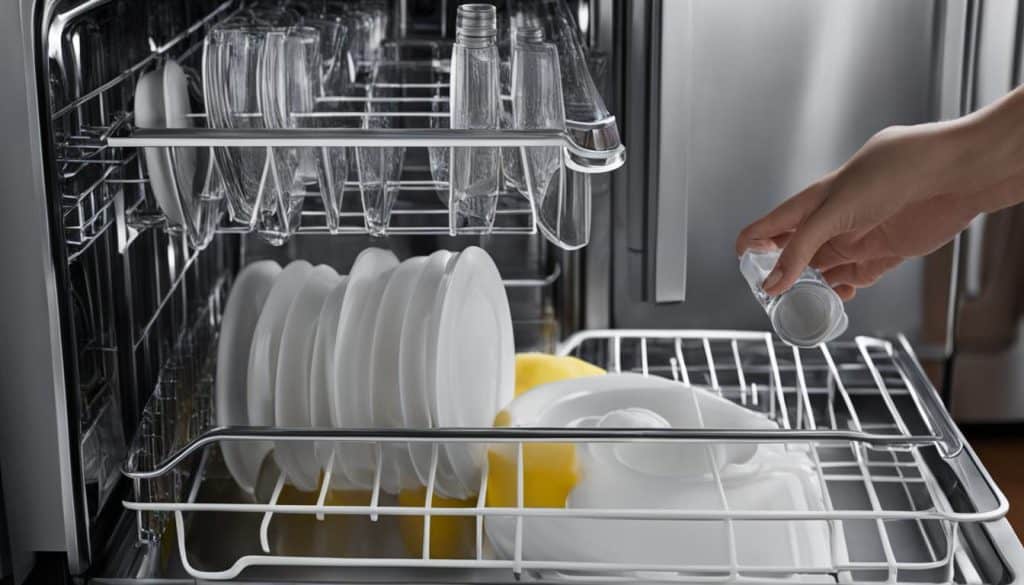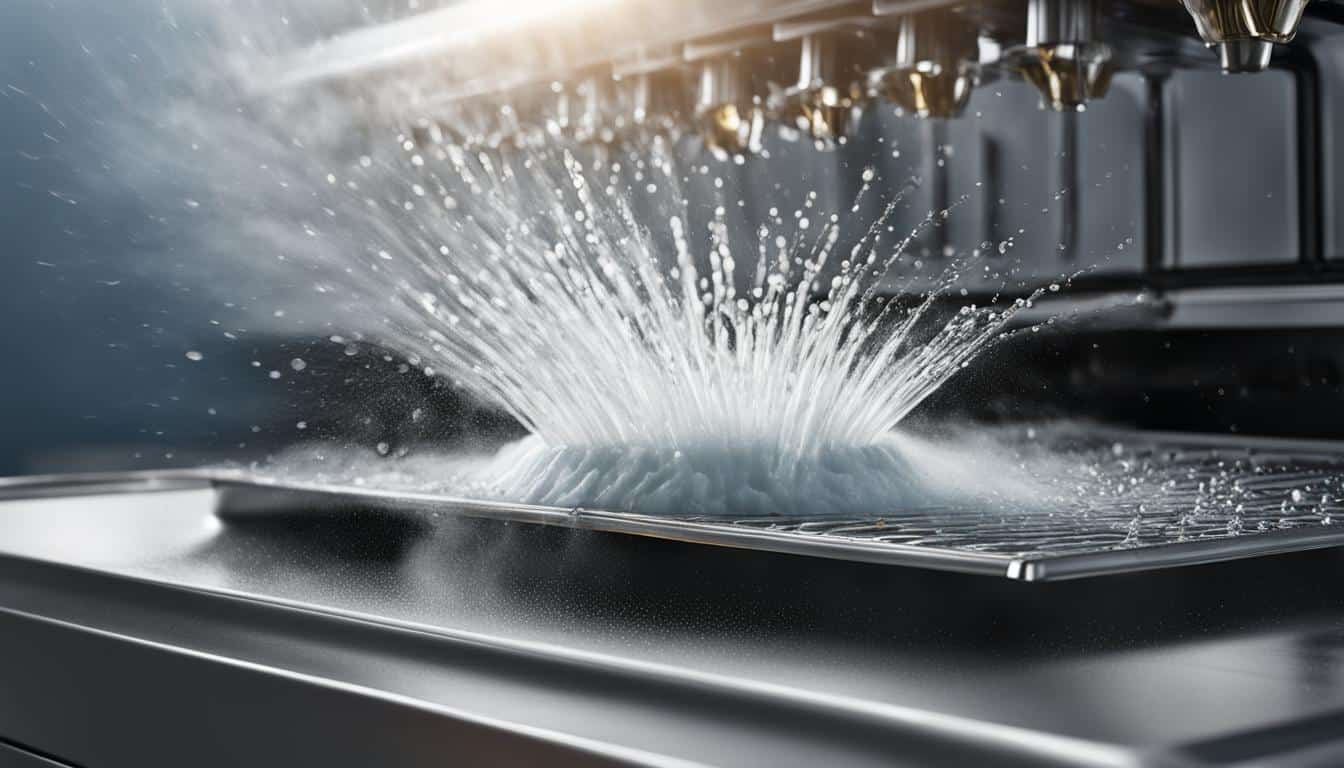The sparkly world of sanitizing your dishwasher. Yup, you heard that right! Even our trusty dish-cleaning buddy needs a bath now and then. Imagine this: you’re a detective, and your mission is to fight the sneaky germs and icky mold hiding in your dishwasher. Sounds like an adventure, huh?
So, how do we turn our dishwashers from grimy to shiny? First up, meet vinegar, our sour-smelling superhero. Just pour a cup in the bottom and let your dishwasher run a hot water cycle. It’s like a spa day for your dishwasher, fizzing away the grime.
But wait, there’s more! Our next secret weapon is baking soda. Sprinkle some on the bottom and run a short cycle. It’s like magic dust that makes bad smells disappear!
Now, here’s the cherry on top: regular maintenance. It’s like brushing your teeth but for your dishwasher. Use a rinse aid to keep those glasses sparkling and check for food bits that might be t owing a party in the filter.
Remember, a happy dishwasher means happy dishes, and happy dishes mean a happy you! So, let’s roll up our sleeves and give our dishwasher the love it deserves. Isn’t it fun to be the hero in the story of clean dishes? Happy cleaning, my friend!
Regular Cycle Maintenance
Regular cycle maintenance is crucial for keeping your dishwasher in optimal condition. Running a hot water cycle monthly, even if your dishes seem clean, is essential. Doing so ensures that any remaining debris or lingering bacteria is removed, preventing buildup and potential blockages.
If your dishwasher has a designated “sanitizing” cycle, take advantage of it! This cycle elevates the water temperature to incredibly high levels, killing any lingering germs or bacteria.
To prevent bacteria growth and obstruction during the cleaning process, it is essential to clean filters and racks regularly. Remove any debris and buildup with warm soapy water and a soft brush. Doing so will ensure that your dishwasher continues to clean effectively and efficiently.
Wipe Down the Door Gasket
One of the often-neglected parts of a dishwasher is the rubber gasket sealing the door. If you don’t wipe down the door gasket regularly, it can accumulate food debris and moisture, leading to mold and foul odors.
To avoid these issues, it’s essential to incorporate wiping down the door gasket as part of your dishwasher cleaning routine.
Here’s how you do it:
- Open the dishwasher door to expose the rubber gasket.
- Wipe down the gasket with a damp cloth to remove visible debris and food particles.
- Use a solution of white vinegar and warm water to eliminate any lingering odors or mold. Simply dampen a cloth with the vinegar solution and wipe down the gasket thoroughly.
- Leave the dishwasher door open for a while to dry the gasket and prevent moisture buildup.
Cleaning the door gasket regularly can help keep your dishwasher smelling fresh and prevent potential health hazards caused by mold and bacteria. So, don’t forget to wipe down the door gasket often!
Deep Cleaning Strategies
When it comes to deep cleaning your dishwasher, there are t ee effective strategies you can use: vinegar rinse, baking soda blast, and commercial dishwasher cleaner. Each method has its own benefits, and the right choice for you may depend on the severity of the dirt and stains in your dishwasher.
Vinegar Rinse
A vinegar rinse is a natural and inexpensive way to deep clean your dishwasher. Simply fill a dishwasher-safe cup with vinegar and place it in the top rack of your dishwasher. Run a hot water cycle with no dishes inside to allow the vinegar to circulate and clean your dishwasher thoroughly.
Vinegar’s acidic properties will help remove tough stains, mineral buildup, and odors in your dishwasher, leaving it smelling fresh and looking spotless. For best results, perform a vinegar rinse at least once a month.
Baking Soda Blast
Baking soda is a versatile kitchen staple that can also be used to deep clean your dishwasher. Sprinkle a cup of baking soda on the bottom of your dishwasher and run a hot water cycle with no dishes inside.
Baking soda’s abrasive properties will help remove stubborn stains and debris, while also neutralizing any unpleasant odors. Baking soda is an eco-friendly and budget-friendly alternative to commercial dishwasher cleaners, making it an excellent choice for environmentally conscious households.
Commercial Dishwasher Cleaner
If you prefer a commercial solution, there are many dishwasher cleaners available in the market that effectively remove stains, mineral deposits, and odors. You can choose from powders, liquids, or tablets, depending on your preference.
Make sure to follow the manufacturer’s instructions carefully and select a cleaner that is compatible with your dishwasher model. Commercial dishwasher cleaners are convenient and easy to use, making them a great option for busy households or if you need a quick and reliable deep cleaning solution.
Regardless of the deep cleaning method you choose, it’s important to perform regular maintenance and upkeep of your dishwasher to prevent the build-up of dirt and grime. By following these deep cleaning strategies, you can keep your dishwasher in tip-top shape and ensure your dishes are always impeccably clean.

Additional Tips
Keeping your dishwasher in top shape requires more than just regular maintenance and deep cleaning. Here are some additional tips to make sure you’re getting the most out of your dishwasher:
Avoid overloading the dishwasher
While it may be tempting to cram as many dirty dishes as possible into your dishwasher to save time, overloading it can actually lead to less effective cleaning.
The water and detergent can’t reach every nook and cranny of your dishes when they’re piled on top of each other. This can result in residue buildup, which can eventually cause unpleasant odors and other issues.
Scrape food leftovers
Before placing your dishes in the dishwasher, give them a quick scrape to remove any large food particles. This will prevent excess food debris from clogging your dishwasher’s filters and pipes, resulting in more efficient cleaning and less likelihood of standing water.
Store the dishwasher door open
Once you’ve finished using your dishwasher, make sure to leave the door slightly ajar to allow for proper ventilation. This can help prevent the growth of mildew and mold inside the dishwasher, which can lead to unpleasant odors over time.
Address standing water
Standing water in your dishwasher can be a sign of drainage or pump problems. If you notice this issue, address it immediately by checking for clogs in the filters and pipes, and ensuring proper installation and drainage of your dishwasher.

By following these additional tips, you can ensure optimal performance and hygiene of your dishwasher, leading to cleaner dishes and a healthier kitchen environment.
Conclusion
By following the essential hygiene practices outlined in this article, you can ensure that your dishwasher remains sanitized and free from harmful germs.
Remember to perform regular cycle maintenance, clean the filters and racks, and wipe down the door gasket regularly. And when it comes to deep cleaning, try out the vinegar rinse, baking soda blast, or commercial dishwasher cleaner methods.
Additionally, be sure to avoid overloading the dishwasher, properly scrape excess food, store the door open to prevent mildew, and address any standing water issues as soon as possible. These simple actions can go a long way in keeping your dishwasher at its best and your dishes sparkling clean.
Thank you for reading and happy cleaning!


